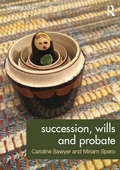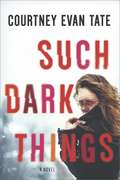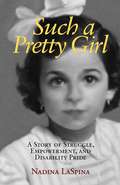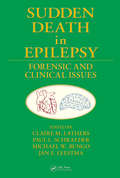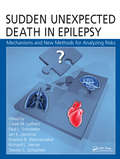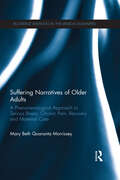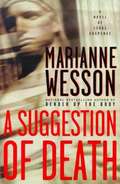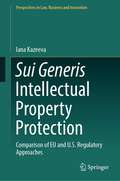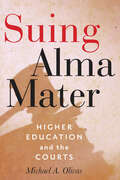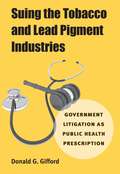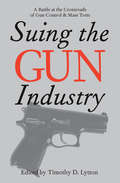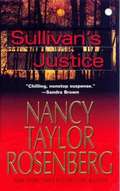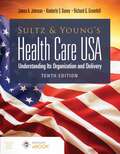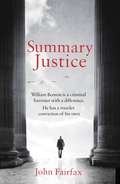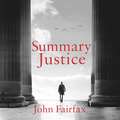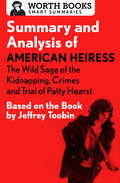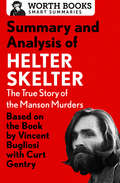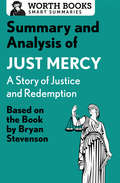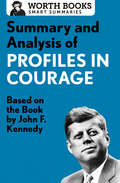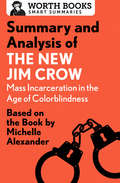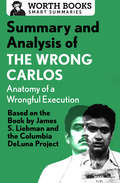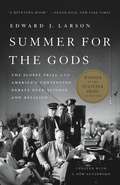- Table View
- List View
Succession, Wills and Probate
by Caroline Sawyer Miriam SperoSuccession, Wills and Probate is an ideal textbook for those taking an undergraduate course in this surprisingly vibrant subject, and also provides a clear and comprehensive introduction for professionals. Against an account of the main social and political themes of succession law, the book gives detailed explanations of core topics such as alternatives to wills and the making, altering and revocation of wills. It also explains personal representatives and how they should deal with a deceased person's estate and interpret and implement the will. Gifts may fail, estates may be insolvent or a person may die intestate, without a will at all. Increasingly relatives and others seek to challenge the will, for example on the grounds of the testator's capacity or under the law of family provision. This third edition is edited, updated and revised to take account of new legislation and case law across all the relevant issues, including a new final chapter dealing with the potentially contentious issues that are becoming more central to professional work in the field of succession.
Such Dark Things: A Novel of Psychological Suspense
by Courtney Evan TateA HORRIFIC RECURRING NIGHTMARE IS THREATENING TO STEAL HER SANITY…Dr. Corinne Cabot is living the American dream. She’s a successful ER physician in Chicago who’s married to a handsome husband. Together they live in a charming house in the suburbs. But appearances can be deceiving—and what no one can see is Corinne’s dark past. Troubling gaps in her memory mean she recalls little about a haunting event in her life years ago that changed everything.She remembers only being in the house the night two people were found murdered. Her father was there, too. Now her father is in prison; she hasn’t been in contact in years. Repressing that terrifying memory has caused Corinne moments of paranoia and panic. Sometimes she thinks she sees things that aren’t there, hears words that haven’t been spoken. Or have they? She fears she may be losing her mind, unable to determine what’s real and what’s not.So when she senses her husband’s growing distance, she thinks she’s imagining things. She writes her suspicions off to fatigue, overwork, anything to explain what she can’t accept—that her life really isn’t what it seems.
Such a Pretty Girl: A Story of Struggle, Empowerment, and Disability Pride
by Nadina LaSpinaA memoir by a disability rights activist Such a Pretty Girl is Nadina LaSpina's story—from her early years in her native Sicily, where still a baby she contracts polio, a fact that makes her the object of well-meaning pity and the target of messages of hopelessness; to her adolescence and youth in America, spent almost entirely in hospitals, where she is tortured in the quest for a cure and made to feel that her body no longer belongs to her; to her rebellion and her activism in the disability rights movement.LaSpina’s personal growth parallels the movement’s political development—from coming together, organizing, and fighting against exclusion from public and social life, to the forging of a common identity, the blossoming of disability arts and culture, and the embracing of disability pride.While unique, the author's journey is also one with which many disabled people can identify. It is the journey to find one's place in an ableist world—a world not made for disabled people, where disability is only seen in negative terms. La Spina refutes all stereotypical narratives of disability. Through the telling of her life’s story, without editorializing, she shows the harm that the overwhelming focus on pity and on a cure that remains elusive has done to disabled people. Her story exposes the disability prejudice ingrained in our sociopolitical system and denounces the oppressive standards of normalcy in a society that devalues those who are different and denies them basic rights.Written as continuous narrative and in a subtle and intimate voice, Such a Pretty Girl is a memoir as captivating as a novel. It is one of the few disability memoirs to focus on activism, and one of the first by an immigrant.
Sudden Death in Epilepsy: Forensic and Clinical Issues
by Jan E. Leestma Claire M. Lathers Paul L. Schraeder Michael W. BungoThough it is one of the most common causes of death in epilepsy patients, SUDEP is still infrequently and even reluctantly named on autopsy reports. This under-reporting equates to a lack of attention and earnest investigation into the cause, predisposition, and prevention of SUDEP. There is as yet little effort to establish an actionable strategy
Sudden Unexpected Death in Epilepsy: Mechanisms and New Methods for Analyzing Risks
by Steven C. Schachter Jan E. Leestma Claire M. Lathers Paul L. Schraeder Braxton B. Wannamaker Richard L. VerrierSudden Unexpected Death in Epilepsy: Mechanisms and New Methods for Analyzing Risks builds on earlier works focusing on the clinical problem of sudden unexpected death in epilepsy (SUDEP). This book presents a methodology for identifying and classifying clusters of risks that lead to SUDEP. Developed over the last two years, the SUDEP Classificatio
Suffering Narratives of Older Adults: A Phenomenological Approach to Serious Illness, Chronic Pain, Recovery and Maternal Care (Routledge Advances in the Medical Humanities)
by Mary Beth MorrisseyIn Suffering Narratives of Older Adults, Mary Beth Quaranta Morrissey turns to the traditions of phenomenology, humanistic psychology and social work to provide an in-depth exploration of the deep structure of the suffering experience. She draws upon the notion of maternal holding to develop an original construct of maternal affordances – the ground of possibility for human development, agency and relational practices. The conceptual analysis is based on the life narratives of several elders receiving chronic care in facility environments. Creating new fields of communication for patients, their family members and health professionals in processes of reflection and shared decision making, this book builds on knowledge about suffering to help guide ethical action in preventing and relieving chronic pain and improving systems of care. It offers a phenomenological approach to understanding the maternal as a primary domain of moral experience in serious illness and suffering, and implications for policy, practice and research. A series of applied chapters, looking at individual experiences of suffering and care experiences, present critical areas of ethical inquiry, including: pain and suffering maternal relational ethics evaluation and moral deliberation about care options decision-making and moral agency end-of-life experiences of care. Exploring how an ecological relational perspective grounded in phenomenology may provide fruitful alternatives to traditional frameworks in bioethics, this is an important contribution to the ongoing development of an ecological ethic of care. It will be of interest to scholars and students of bioethics and phenomenological methods in the health and human services, as well as practitioners in the field.
Suffering in Silence: The Links between Human Rights Abuses and HIV Transmission to Girls in Zambia
by Human Rights WatchSexual abuse of girls in Zambia fuels the HIV/AIDS epidemic and the strikingly higher HIV prevalence among girls than boys, Human Rights Watch said today. Concerted national and international efforts to protect the rights of girls and young women are key to curbing the AIDS epidemic's destructive course.
Sugar and the Making of International Trade Law
by Michael FakhriThis book traces the changing meanings of free trade over the past century through three sugar treaties and their concomitant institutions. The 1902 Brussels Convention is an example of how free trade buttressed the British Empire. The 1937 International Sugar Agreement is a story of how a group of Cubans renegotiated their state's colonial relationship with the US through free trade doctrine and the League of Nations. And the study of the 1977 International Sugar Agreement maps the world of international trade law through a plethora of institutions such as the ITO, UNCTAD, GATT and international commodity agreements - all against the backdrop of competing Third World agendas. Through a legal study of free trade ideas, interests and institutions, this book highlights how the line between the state and market, domestic and international, and public and private is always a matter of contest.
Suggestion of Death
by Marianne WessonIn her national bestseller Render Up the Body, former federal prosecutor Marianne Wesson delivered an "intense legal drama". Now, Wesson's unforgettable heroine, Colorado attorney Cinda Hayes, is the heart and soul of a thrilling and authentic new novel -- a page-turner that ranks with the best suspense fiction of Scott Turow and Linda Fairstein.
Sui Generis Intellectual Property Protection: Comparison of EU and U.S. Regulatory Approaches (Perspectives in Law, Business and Innovation)
by Iana KazeevaThe standard forms of intellectual property protection, namely, copyright, patents, trademarks and trade secrets, have a long history and are well regulated in the legislative systems of most jurisdictions. However, there are specific kinds of subject matter that, due to their characteristics, cannot be adequately protected by these standard forms of intellectual property instruments. At the same time, these categories of subject matter require legal protection in order to ensure the balance between the public's access to these creations and the creators' rights. For these reasons, many jurisdictions introduce a special form of intellectual property protection, namely, sui generis regime, i.e., intellectual property legal regime “of its own kind”, designed to serve the specific needs of a particular subject matter. This book analyzes the intellectual property protection regimes in the EU and the U.S. available for three categories of subject matter that are often considered as requiring sui generis protection, namely, databases, designs and plant varieties. One of the main objectives is to evaluate whether the chosen subject matter in fact requires sui generis intellectual property protection and whether the introduced sui generis regimes have proved to be successful over time. The final chapter of this book analyses the perspectives of sui generis intellectual property protection for works generated by AI systems. This volume offers a comprehensive analysis of sui generis intellectual property rights and will be a key source for both scholars and practitioners with an interest in intellectual property law.
Suing Alma Mater: Higher Education and the Courts
by Michael A. OlivasThis careful reading of six legal cases in American higher education is an essential primer for understanding contemporary litigation.Winner of the Steven S. Goldberg Award for Distinguished Scholarship in Education Law of the Education Law AssociationAlthough much has been written about U.S. Supreme Court decisions involving higher education, little has been said about the foundational case law and litigation patterns emerging from the lower courts. As universities become increasingly legislated, regulated, and litigious, campuses have become testing grounds for a host of constitutional challenges. From faculty and student free speech to race- or religion-based admissions policies, Suing Alma Mater describes the key issues at play in higher education law.Eminent legal scholar Michael A. Olivas considers higher education litigation in the latter half of the twentieth century and the rise of "purposive organizations," like the American Civil Liberties Union and the Alliance Defense Fund (now known as the Alliance Defending Freedom), that exist to advance litigation. He reviews more than 120 college cases brought before the Supreme Court in the past fifty years and then discusses six key cases in depth. Suing Alma Mater provides a clear-eyed perspective on the legal issues facing higher education today.
Suing The Tobacco And Lead Pigment Industries
by Donald G. Gifford"The topic, how tort law evolved over time into a system that allowed, for a moment at least, a parens patriae form of massive litigation against corporations, is exceedingly interesting and important. Gifford's treatment of this topic is highly informative, engaging, insightful, very current, and wise. " ---David Owen, Carolina Distinguished Professor of Law, and Director of Tort Law Studies, University of South Carolina InSuing the Tobacco and Lead Pigment Industries, legal scholar Donald G. Gifford recounts the transformation of tort litigation in response to the challenge posed by victims of 21st-century public health crises who seek compensation from the product manufacturers. Class action litigation promised a strategy for documenting collective harm, but an increasingly conservative judicial and political climate limited this strategy. Then, in 1995, Mississippi attorney general Mike Moore initiated aparens patriaeaction on behalf of the state against cigarette manufacturers. Forty-five other states soon filed public product liability actions, seeking both compensation for the funds spent on public health crises and the regulation of harmful products. Gifford finds that courts, through their refusal to expand traditional tort claims, have resisted litigation as a solution to product-caused public health problems. Even if the government were to prevail, the remedy in such litigation is unlikely to be effective. Gifford warns, furthermore, that by shifting the powers to regulate products and to remediate public health problems from the legislature to the state attorney general,parens patriaelitigation raises concerns about the appropriate allocation of powers among the branches of government. Donald G. Gifford is the Edward M. Robertson Research Professor of Law at the University of Maryland School of Law.
Suing the Gun Industry: A Battle at the Crossroads of Gun Control and Mass Torts
by Timothy D. Lytton"Mass tort litigation against the gun industry, with its practical weaknesses, successes, and goals, provides the framework for this collection of thoughtful essays by leading social scientists, lawyers, and academics. . . . These informed analyses reveal the complexities that make the debate so difficult to resolve. . . . Suing the Gun Industry masterfully reveals the many details contributing to the intractability of the gun debate. " -New York Law Journal "Second Amendment advocate or gun-control fanatic, all Americans who care about freedom need to readSuing the Gun Industry. " -Bob Barr, Member of Congress, 1995-2003, and Twenty-First Century Liberties Chair for Freedom and Privacy, American Conservative Union "Thesource for anyone interested in a balanced analysis of the lawsuits against the gun industry. " -David Hemenway, Professor of Health Policy & Director, Harvard Injury Control Research Center Harvard School of Public Health Health Policy and Management Department, author ofPrivate Guns, Public Health "Highly readable, comprehensive, well-balanced. It contains everything you need to know, and on all sides, about the wave of lawsuits against U. S. gun manufacturers. " -James B. Jacobs, Warren E. Burger Professor of Law and author ofCan Gun Control Work? "InSuing the Gun Industry, Timothy Lytton has assembled some of the leading scholars and advocates, both pro and con, to analyze this fascinating effort to circumvent the well-known political obstacles to more effective gun control. This fine book offers a briefing on both the substance and the legal process of this wave of lawsuits, together with a better understanding of the future prospects for this type of litigation vis-à-vis other industries. " -Philip J. Cook, Duke University "An interesting collection, generally representing the center of the gun-control debate, with considerable variation in focus, objectivity, and political realism. " -Paul Blackman, retired pro-gun criminologist and advocate Gun litigation deserves a closer look amid the lessons learned from decades of legal action against the makers of asbestos, Agent Orange, silicone breast implants, and tobacco products, among others. Suing the Gun Industrycollects the diverse and often conflicting opinions of an outstanding cast of specialists in law, public health, public policy, and criminology and distills them into a complete picture of the intricacies of gun litigation and its repercussions for gun control. Using multiple perspectives,Suing the Gun Industryscrutinizes legal action against the gun industry. Such a broad approach highlights the role of this litigation within two larger controversies: one over government efforts to reduce gun violence, and the other over the use of mass torts to regulate unpopular industries. Readers will findSuing the Gun Industrya timely and accessible picture of these complex and controversial issues. Contributors: Tom Baker Donald Braman Brannon P. Denning Tom Diaz Howard M. Erichson Thomas O. Farrish Shannon Frattaroli John Gastil Dan M. Kahan Don B. Kates Timothy D. Lytton Julie Samia Mair Richard A. Nagareda Peter H. Schuck Stephen D. Sugarman Stephen Teret Wendy Wagner
Sullivan's Justice
by Nancy Taylor RosenbergProbation officer Carolyn Sullivan's brother discovers the body of his girlfriend in his swimming pool, and soon he's the prime suspect.
Sultz and Young's Health Care USA: Understanding Its Organization and Delivery
by James A. Johnson Kimberly S. Davey Richard G. GreenhillCombining historical perspective with analysis of current trends, Sultz & Young's Health Care USA, Tenth Edition charts the evolution of modern American health care, providing a complete examination of its organization and delivery while offering critical insight into the issues that the U.S. health system faces today.Building on the legacy of its prior successful editions, new co-authors James Johnson, Kim Davey, and Richard Greenhill lend their deep expertise in health services planning, administration, quality assessment, and teaching to the Tenth Edition by providing an updated, wide-ranging, and timely view of today's health care delivery system. New! Health systems thinking perspective is used as the organizing framework throughout, addressing a core Council on Education for Public Health (CEPH) competency. New chapters address important aspects of the U.S. health system such as Public Policy and the Role of Government in Health Care (3); Health Services and System Research (12); Preparedness and Emergency Management (13); and Rural Health (14).New assignments, cases, and interviews engage learners and encourage better comprehension of concepts and issues.New appendix provides an in-depth analysis of the Canadian health system to help learners identify the similarities and differences between the U.S. and Canadian health systems. All chapters were revised and updated to reflect current developments and trends in the field such as the COVID-19 pandemic, diversity, equity, and inclusion, artificial intelligence, machine learning, and much more. A final chapter explores innovation in technology, workforce trends, and other challenges and opportunities facing the U.S. health system. Upper-level undergraduate and graduate courses covering the U.S. health care system in a wide range of health-oriented degree programs: Health Care Administration, Business, Nursing, Health Science, Pharmacy, Physical Therapy, Public Health and Public Administration. Courses include: Health Care Delivery Systems Intro to the US Healthcare System Health Care in America Healthcare Organization and Administration Current Issues/Contemporary Environment in Health Care © 2023 | 475 pages
Summary Justice: 'An all-action court drama' Sunday Times (Benson and De Vere)
by John FairfaxThe last time Tess de Vere saw William Benson she was a law student on work experience. He was a twenty-one year old, led from the dock of the Old Bailey to begin a life sentence for murder. He'd said he was innocent. She'd believed him.Sixteen years later Tess overhears a couple of hacks mocking a newcomer to the London Bar, a no-hoper with a murder conviction, running his own show from an old fishmonger's in Spitalfields. That night she walks back into Benson's life. The price of his rehabilitation - and access to the Bar - is an admission of guilt to the killing of Paul Harbeton, whose family have vowed revenge. He's an outcast. The government wants to shut him down and no solicitor will instruct him. But he's subsidised by a mystery benefactor and a desperate woman has turned to him for help: Sarah Collingstone, mother of a child with special needs, accused of slaying her wealthy lover. It's a hopeless case and the murder trial, Benson's first, starts in four days. The evidence is overwhelming but like Benson long ago, she swears she's innocent. Tess joins the defence team, determined to help Benson survive. But as Benson follows the twists and turns in the courtroom, Tess embarks upon a secret investigation of her own, determined to uncover the truth behind the death of Paul Harbeton on a lonely night in Soho.True to life, fast-paced and absolutely compelling, Summary Justice introduces a new series of courtroom dramas featuring two maverick lawyers driven to fight injustice at any cost.
Summary Justice: 'An all-action court drama' Sunday Times (Benson and De Vere)
by John FairfaxThe last time Tess de Vere saw William Benson she was a law student on work experience. He was a twenty-one year old, led from the dock of the Old Bailey to begin a life sentence for murder. He'd said he was innocent. She'd believed him.Sixteen years later Tess overhears a couple of hacks mocking a newcomer to the London Bar, a no-hoper with a murder conviction, running his own show from an old fishmonger's in Spitalfields. That night she walks back into Benson's life. The price of his rehabilitation - and access to the Bar - is an admission of guilt to the killing of Paul Harbeton, whose family have vowed revenge. He's an outcast. The government wants to shut him down and no solicitor will instruct him. But he's subsidised by a mystery benefactor and a desperate woman has turned to him for help: Sarah Collingstone, mother of a child with special needs, accused of slaying her wealthy lover. It's a hopeless case and the murder trial, Benson's first, starts in four days. The evidence is overwhelming but like Benson long ago, she swears she's innocent. Tess joins the defence team, determined to help Benson survive. But as Benson follows the twists and turns in the courtroom, Tess embarks upon a secret investigation of her own, determined to uncover the truth behind the death of Paul Harbeton on a lonely night in Soho.True to life, fast-paced and absolutely compelling, Summary Justice introduces a new series of courtroom dramas featuring two maverick lawyers driven to fight injustice at any cost.
Summary and Analysis of American Heiress: Based on the Book by Jeffrey Toobin
by Worth BooksSo much to read, so little time? This brief overview of American Heiress tells you what you need to know--before or after you read Jeffrey Toobin's book. Crafted and edited with care, Worth Books set the standard for quality and give you the tools you need to be a well-informed reader. This short summary and analysis of American Heiress by Jeffrey Toobin includes: Historical contextChapter-by-chapter summariesDetailed timeline of key eventsProfiles of the main charactersImportant quotesFascinating triviaGlossary of termsSupporting material to enhance your understanding of the original work About American Heiress by Jeffrey Toobin: Bestselling author Jeffrey Toobin's American Heiress is a thorough true crime account of the kidnapping and trial of Patty Hearst, whose sensational journey gripped the nation and defined a tumultuous period in American history. On February 4, 1974, Patricia Hearst--the heiress to the Hearst family fortune--was abducted by a group of left-wing revolutionaries called the Symbionese Liberation Army (SLA). What started as a media sensation turned into a circus when a recording was released in which Patty claimed she was joining the movement and her new name was Tania. Set against the backdrop of an already turbulent era, and based on hundreds of interviews and never-before-seen documents, American Heiress is a revelatory look at one of the most famous abductions of the twentieth century. The summary and analysis in this ebook are intended to complement your reading experience and bring you closer to a great work of nonfiction.
Summary and Analysis of Helter Skelter: Based on the Book by Vincent Bugliosi with Curt Gentry (Smart Summaries)
by Worth BooksSo much to read, so little time? This brief overview of Helter Skelter tells you what you need to know—before or after you read Vincent Bugliosi and Curt Genry&’s book. Crafted and edited with care, Worth Books set the standard for quality and give you the tools you need to be a well-informed reader. This summary of Helter Skelter by Vincent Bugliosi with Curt Gentry includes: Historical contextSection-by-section overviewsDetailed timeline of eventsAnalysis of the main charactersFascinating triviaGlossary of termsSupporting material to enhance your understanding of the original work About Vincent Bugliosi and Curt Gentry&’s Helter Skelter: In the bestselling true crime book Helter Skelter, lead prosecutor Vincent Bugliosi provides a meticulously detailed account of the murders committed by the Manson family and their trial—one of the most sensational criminal cases of the century. From the police investigation of the murders of Leno and Rosemary LaBianca and Sharon Tate, to the arrests, the courtroom antics, and the personalities and motivations of Charles Manson and his followers, Helter Skelter offers a haunting look into the horrific repercussions of cult mentality on a violent rampage. The summary and analysis in this ebook are intended to complement your reading experience and bring you closer to a great work of nonfiction.
Summary and Analysis of Just Mercy: Based on the Book by Bryan Stevenson
by Worth BooksSo much to read, so little time? This brief overview of Just Mercy: A Story of Justice and Redemption tells you what you need to know—before or after you read Bryan Stevenson book. Crafted and edited with care, Worth Books set the standard for quality and give you the tools you need to be a well-informed reader. This short summary and analysis of Just Mercy includes: Historical contextChapter-by-chapter overviewsCharacter profilesDetailed timeline of key eventsImportant quotes and analysisFascinating triviaGlossary of termsSupporting material to enhance your understanding of the original work About Just Mercy: A Story of Justice and Redemption by Bryan Stevenson: Just Mercy is a heartbreaking—but not entirely hopeless—look inside the American criminal justice system. The guide on this journey to death row, judges’ chambers, and courthouses small and large is Bryan Stevenson, one of the country’s foremost criminal justice reformers and the founder of the Equal Justice Initiative, the acclaimed legal aid organization based in Montgomery, Alabama. In Stevenson’s chronicle, the only thing standing between death or life imprisonment is an underpaid, overworked lawyer. The summary and analysis in this ebook are intended to complement your reading experience and bring you closer to a great work of nonfiction.
Summary and Analysis of Profiles in Courage: Based on the Book by John F. Kennedy (Smart Summaries)
by Worth BooksSo much to read, so little time? This brief overview of Profiles in Courage tells you what you need to know—before or after you read John F. Kennedy&’s book. Crafted and edited with care, Worth Books set the standard for quality and give you the tools you need to be a well-informed reader. This short summary and analysis of Profiles in Courage includes: Historical contextChapter-by-chapter overviewsProfiles of the main charactersDetailed timeline of key eventsImportant quotesFascinating triviaGlossary of termsSupporting material to enhance your understanding of the original work About Profiles in Courage by John F. Kennedy: John F. Kennedy&’s Profiles in Courage takes an in-depth look at eight US senators who displayed courage by going against their political party&’s platform and acting on integrity and convictions. These timeless stories of political courage and inner strength are no less poignant today than upon the book&’s original publication in 1955. The summary and analysis in this ebook are intended to complement your reading experience and bring you closer to a great work of nonfiction.
Summary and Analysis of The New Jim Crow: Based on the Book by Michelle Alexander
by Worth BooksSo much to read, so little time? This brief overview of The New Jim Crow tells you what you need to know--before or after you read Michelle Alexander's book. Crafted and edited with care, Worth Books set the standard for quality and give you the tools you need to be a well-informed reader. This short summary and analysis of The New Jim Crow by Michelle Alexander includes: Historical context Chapter-by-chapter summaries Detailed timeline of key events Profiles of the main characters Important quotes Fascinating trivia Glossary of terms Supporting material to enhance your understanding of the original work About The New Jim Crow by Michelle Alexander: Legal scholar and civil rights lawyer Michelle Alexander's invaluable and timely work, The New Jim Crow, examines what she calls the new racial caste system in United States: mass incarceration. Following the practices of slavery and institutional discrimination, Alexander argues, mass incarceration is part of America's legacy to dehumanize and disenfranchise African Americans and Latinos. According to Alexander, "we have not ended racial caste in America; we have merely redesigned it." Thanks in a large part to the War on Drugs, more than two million people are in America's prisons today--an overwhelming majority of them are people of color who've been jailed for minor drug charges. When these adults leave prison, they are often denied employment, housing, the right to vote, and a quality education. As a result, they are rarely able to integrate successfully into society. The New Jim Crow is a well-argued call to dismantle a system of policies that continues to deny civil rights, decades after the passing of the Civil Rights and Voting Rights Acts. The summary and analysis in this ebook are intended to complement your reading experience and bring you closer to a great work of nonfiction.
Summary and Analysis of The Wrong Carlos: Based on the Book by James S. Liebman
by Worth BooksSo much to read, so little time? This brief overview of The Wrong Carlos: Anatomy of a Wrongful Execution tells you what you need to know—before or after you read James S. Liebman and the Columbia DeLuna Project’s book. Crafted and edited with care, Worth Books set the standard for quality and give you the tools you need to be a well-informed reader. This short summary and analysis of The Wrong Carlos: Anatomy of a Wrongful Execution by James S. Liebman and the Columbia DeLuna Project includes: Historical contextChapter-by-chapter summariesDetailed timeline of important eventsImportant quotesFascinating triviaGlossary of terms About James S. Liebman and the Columbia DeLuna Project’s The Wrong Carlos: Anatomy of a Wrongful Execution: The Wrong Carlos calls into question the United States justice system and its ability to impose the death penalty with impartiality and certainty through an in-depth examination of an obscure capital murder case from the 1980s. In Corpus Christi, Texas, a man named Carlos DeLuna was executed for the murder of Wanda Vargas Lopez, while a man who looked just like him, Carlos Hernandez, escaped conviction for killing her and others. Columbia Law School professor James S. Liebman and his team from the Columbia DeLuna Project delve into this case of mistaken identity to study how factors such as race, poverty, and reliance upon eyewitness testimony can contribute to erroneous death penalty convictions. In a country where capital punishment remains controversial, The Wrong Carlos asks its readers to consider whether irreversible conviction at the hands of a flawed system is the type of justice Americans want to see served. The summary and analysis in this ebook are intended to complement your reading experience and bring you closer to a great work of nonfiction.
Summer for the Gods: The Scopes Trial and America's Continuing Debate Over Science and Religion
by Edward J. LarsonThe Pulitzer Prize-winning history of the Scopes Trial and the battle over evolution and creation in America's schools.In the summer of 1925, the sleepy hamlet of Dayton, Tennessee, became the setting for one of the twentieth century's most contentious courtroom dramas, pitting William Jennings Bryan and the anti-Darwinists against a teacher named John Scopes, represented by Clarence Darrow and the ACLU, in a famous debate over science, religion, and their place in public education. That trial marked the start of a battle that continues to this day in cities and states throughout the country. Edward Larson's classic Summer for the Gods -- winner of the Pulitzer Prize in History -- is the single most authoritative account of this pivotal event. An afterword assesses the state of the battle between creationism and evolution, and points the way to how it might potentially be resolved.
Summer for the Gods: The Scopes Trial and America's Continuing Debate Over Science and Religion
by Edward LarsonIn the summer of 1925, the sleepy hamlet of Dayton, Tennessee, became the setting for one of the 20th century's most contentious dramas: the Scopes trial that pit William Jennings Bryan and the anti-Darwinists against a teacher named John Scopes into a famous debate over science, religion, and their place in public education That trial marked the start of a battle that continues to this day-in Dover, Pennsylvania, Kansas, Cobb County, Georgia, and many other cities and states throughout the country. Edward Larson's classic, Summer for the Gods, is the single most authoritative account of a pivotal event whose combatants remain at odds in school districts and courtrooms. For this edition, Larson has added a new preface that assesses the state of the battle between creationism and evolution, and points the way to how it might potentially be resolved.<P><P> Pulitzer Prize Winner
